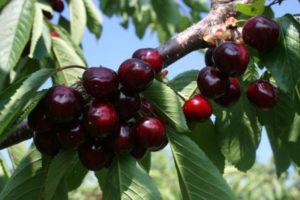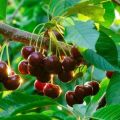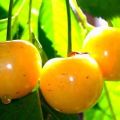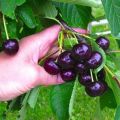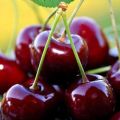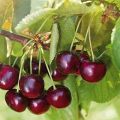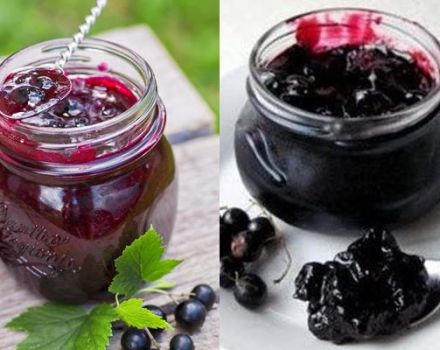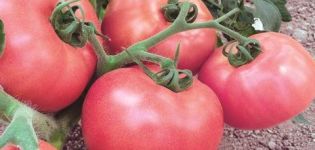Description and characteristics of the sweet cherry varieties Julia, pollinators, planting and care
The sweet cherry variety Julia is a tall tree with large and juicy fruits. The variety is widespread among gardeners in the northern regions and in the Black Earth region.
Breeding history
The variety was bred at an experimental gardening station in the city of Rossosh, Voronezh region. For breeding, seeds of the local selection Ginh red were used, which were pollinated with the Denissen yellow berry variety. Subsequently, the variety was zoned for the Chernozem and Lower Volga regions.
Description of the variety
Having planned the planting of cherries, you should familiarize yourself with the detailed description of the variety. This will help you choose the right place for the plants and think in advance about the upcoming care.
Height and size of the crown
Vigorous and actively growing trees reach a height of more than 8 m. The crown is spreading, medium thickened, well leafy. The shape of the crown is pyramidal, with slightly inclined branches of the lower tier. The bark of the trunk is slightly rough or smooth scaly, gray with a cherry tint.
Resistant to freezing temperatures and drought
Sweet cherry Julia has an indicator of frost resistance above average. Berry trees undergo cold snaps down to -30 degrees. Frost does not affect the development of all plant elements, including flower buds, roots and wood. When growing crops in regions with cold climates, most of the buds freeze out in winter.
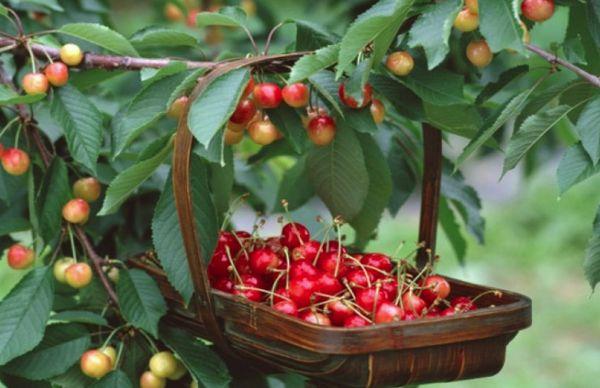
Exposure to insects and disease
The variety has increased resistance to attack by harmful insects and fungal infections. In the case of periodic preventive treatments, the risk of developing gray rot and coccomycosis becomes minimal.
Pollinators
Variety Julia belongs to the category of self-infertile, so it makes no sense to grow trees on the site alone. Good pollinators are required to produce a good and consistent crop. According to experienced breeders, the following varieties are the best pollinators:
- Raditsa;
- Ovstuzhenka;
- Iput;
- Bryansk pink;
- Jealous.
Flowering and ripening period
Trees begin to bloom in early days or in mid-April. The variety has an average ripening period. In areas with a predominantly warm climate, berries ripen by mid-summer. When grown in the middle lane, the crop is harvested in the last decade of August.
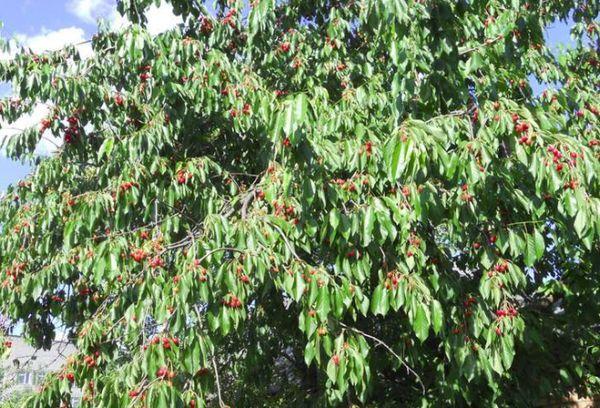
Cherry yield
One of the distinctive features of the Julia variety is a gradual increase in the yield indicator. The first collection is carried out 4-5 years after planting the seedlings in a permanent place. The average yield reaches 15 kg per planting. In the future, the indicator increases to 25 kg. Most actively the amount of the harvest increases when growing berries in the southern regions.
Transportability and storage of crops
Due to the dense fibrous pulp, cherries can be transported over long distances without losing their taste characteristics and losing their presentation. The average storage time for ripe cherries in the refrigerator is 2 weeks. The optimal storage conditions are 0 degrees. If the berry is harvested for future use, then it is placed in the freezer.
Scope of berries
One of the reasons why the Julia cherry is very popular with gardeners is its universal purpose. Berries are suitable for preservation, making jams and preserves, freshly harvested consumption.
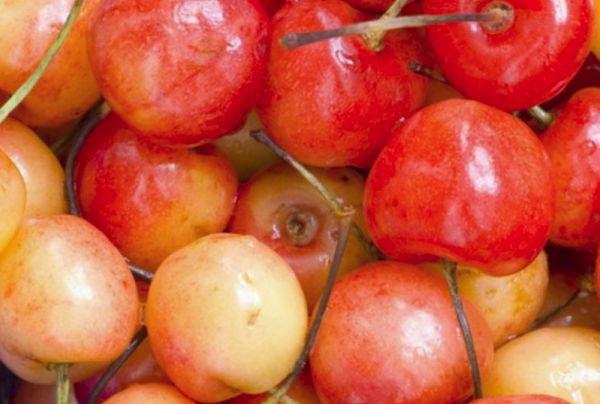
Tree planting technology
Planting trees must be carried out in accordance with the requirements of the variety. Compliance with planting technology promotes active growth and development, helps to avoid common mistakes.
How to choose a healthy and strong seedling
When checking the quality of a seedling, you need to pay attention to its trunk. There should be traces of the scion on it, since such specimens are more fertile. A healthy and developed seedling has many branches, which will form a spreading crown in the future.
The roots of a young seedling should not be dry and strong. It is recommended to wrap the roots in a damp cloth before planting. The leaves on the seedling should be trimmed so that they do not absorb nutrients, weakening the plants.
Dates and scheme of disembarkation on the site
It is recommended to transfer the grafted seedlings into open ground in spring, when the snow cover has already melted, but the buds have not yet blossomed. Autumn planting is also allowed, but in this case it will be necessary to carry out the formation, perform the hilling of the roots and insulate the trunk with a covering material.
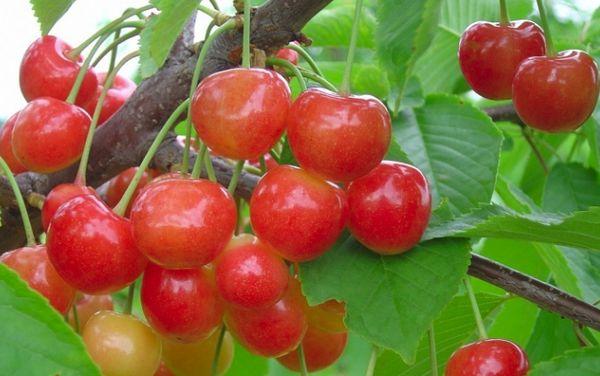
Planting pit preparation
A planting hole for spring planting is dug in advance in the fall. For autumn planting, the pit begins to be prepared in 2-3 weeks. First you need to choose a suitable place for the pit. It is recommended to consider the following requirements:
- The soil should be light and fertile. The acidity index is neutral.
- For the development of roots, moderate moisture is required, the absence of drying out and moisture stagnation.
- Natural light throughout the day will encourage vigorous growth. Slight semi-shading is allowed.
- The planting site should be protected from blowing through and strong gusts of wind.
- The optimal indicator of groundwater occurrence is more than 2.5 m from the ground surface. Otherwise, planting should be carried out on a hill.
What crops can and cannot be planted next to cherries
Sweet cherry Julia is actively developing and bearing fruit when planted next to stone fruit crops, including plum, cherry plum and blackthorn. The main requirement is to observe the optimal distance between plantings, which should be at least 4.5 m. Neighborhood with seed crops is allowed only at an interval of 4-6 m.
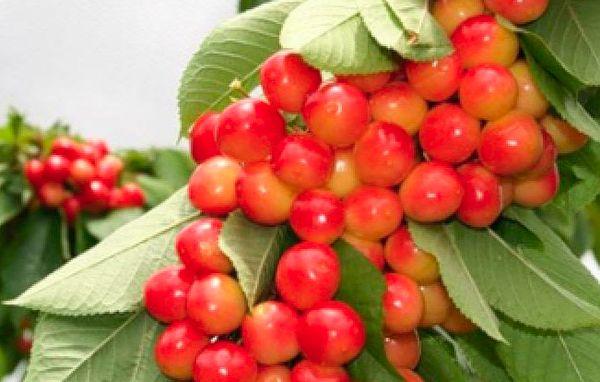
Planting algorithm
When planting cherries, you must follow the step-by-step instructions. Planting operations include the following actions:
- preparation of a pit with dimensions of 70x90 cm;
- processing of the lower layer of the earth with a nutrient mixture of organic fertilizers (humus, wood ash, compost);
- construction of a small elevation in the central part of the pit;
- placing a cherry seedling on a hill and fixing it by tying it to a peg, which is stuck next to the hole;
- sprinkling with earth, compaction, abundant watering and mulching of the tree trunk circle.
We organize the right care
A prerequisite for the development of berry culture and intensive fruiting is constant and proper care. In the process of growing the variety of sweet cherries, Julia, it is required to observe a set of agrotechnical actions, including the use of fertilizers, irrigation, mulching, pruning of plantings, sheltering trees for the winter and preventive spraying to protect against harmful insects and diseases.
Top dressing and watering
Sweet cherries of the Julia variety need moderate watering. It is recommended to moisten the ground as needed, taking into account weather conditions and the amount of precipitation. Before irrigating trees, squeeze a lump of earth from the surface in the palm of your hand - if it crumbles, then another watering is required.

Fertilizers are applied to the soil several times during the season. In autumn, complex fertilizing is used, in which organic substances are combined with mineral ones. In spring, Julia's sweet cherries are fed with fertilizers with a high nitrogen content.
Barrel circle care
Mulching the area of the tree trunk circle is necessary to retain moisture in the soil and reduce the number of watering, protect against insects and diseases, insulate the roots, and eliminate the need to loosen the earth.
Mulching can be carried out immediately after planting the first watering of seedlings. It is recommended to use coniferous branches, compost or sawdust as a material for mulching.
Crown formation
Trees are pruned starting from the 5th year of tree development. The shaping procedure helps to increase the yield, reduces the risk of developing fungal infections and simplifies the process of picking berries. During pruning, old and damaged branches, dried and abundantly overgrown foliage are removed.
The main branch of the tree should always be 20 cm ahead of the rest. When forming, it is important to control the length of all branches. We recommend pruning in late fall or winter when trees are dormant. With the onset of spring, the damaged areas will be tightened, and the plantings will continue to actively develop.

Preventive treatments
Timely preventive treatment of trees helps to reduce the risk of damage to berry crops by pests and diseases. During the season, it is recommended to spray 3-4 times with insecticidal and fungicidal preparations. Also, you should always remove infected parts of the tree from the site.
As an additional measure to combat harmful insects, you can whitewash the tree trunk and use deterrent agents (tapes, ratchets).
Preparing and covering the tree for winter
On the eve of winter cold snaps, it is necessary to cover trees, which is especially important for young and immature seedlings. To protect Julia's cherries, you can use burlap, thick plastic wrap, or a specialized covering material. Pegs are placed in the ground next to the trees and the material is pulled over them, which makes it possible to create a favorable microclimate around the ground part. The ground in the area of the tree trunk circle for the winter is covered with a layer of mulch.
How to propagate cherries
The best way to propagate sweet cherries of the Julia variety is cuttings.The procedure is best performed in late summer or early autumn. Cuttings are taken from the lower branches of an adult tree, the cut is treated with a growth stimulant, and the cut is sprinkled with wood ash on the mother tree. Prepared cuttings are rooted in the open field and provide comprehensive care. For the winter, the cuttings need to be covered so that they continue their development in a comfortable environment.
Reviews of summer residents about the variety
Vasily, 54 years old: “I planted some trees last season. I bought adult seedlings, so at the end of summer I already harvested the first crop. The berries are large and juicy, I used most of them for processing, but fresh they are also very tasty. "
Anna, 35 years old: “I have been growing the Yulia variety for 3 years in a row. I would like to note the high yield and easy maintenance. I have never encountered pests. The only drawback is the high height of the trees, which makes picking berries difficult. "
